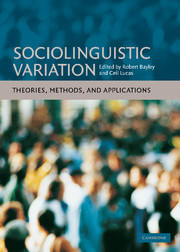Book contents
- Frontmatter
- Contents
- 1 List of figures
- 2 List of tables
- Acknowledgments
- Notes on editors and contributors
- Introduction
- Part 1 THEORIES
- Part 2 METHODS
- 9 Sociolinguistic fieldwork
- 10 Quantitative analysis
- 11 Sociophonetics
- Part 3 APPLICATIONS
- Afterword: Walt Wolfram and the study of sociolinguistic variation
- References
- Index
10 - Quantitative analysis
Published online by Cambridge University Press: 16 February 2010
- Frontmatter
- Contents
- 1 List of figures
- 2 List of tables
- Acknowledgments
- Notes on editors and contributors
- Introduction
- Part 1 THEORIES
- Part 2 METHODS
- 9 Sociolinguistic fieldwork
- 10 Quantitative analysis
- 11 Sociophonetics
- Part 3 APPLICATIONS
- Afterword: Walt Wolfram and the study of sociolinguistic variation
- References
- Index
Summary
Modeling language variation
Quantitative analysis involves an examination of individual instances of linguistic forms in the context of the grammar from which they come. Thus, quantitative analysis is not so much interested in individual occurrences of linguistic features (i.e. tokens), but the recurrent choices an individual makes in the course of linguistic performance (i.e. patterns of occurrence) (Poplack and Tagliamonte 2001:89). These choices are taken to represent the (underlying) variable grammar of the speaker as well as the speech community to which she belongs.
In this chapter I will demonstrate quantitative analysis by using a well-known (and popular) linguistic feature as a case study – the use of quotative “be like,” as in (1a–c).
(a) 'Cause then they were talking about Krispy Kreme and then Tita Laura was like, “Oh, I've never been there, do they sell coffee there?” And Tito Emilio was like, “No, I don't think so. It's just doughnuts.” And I'm like, “No, they sell coffee too.” And she's like, “Oh yeah?” And then he's like, “Oh yeah?” And I was like, “Yeah.” (CF/16/02)
(b) So then, she was like, “Oh, it's okay. Just remember to count to five and everything's okay.” And I was like, “Oh, that's, that's okay.” So then um, today she asked me again, “How are you juggling everything. I hope everything's going okay.” And I said, “Well not really this week. This week is really stressful.” (CF/17/03)
[…]
- Type
- Chapter
- Information
- Sociolinguistic VariationTheories, Methods, and Applications, pp. 190 - 214Publisher: Cambridge University PressPrint publication year: 2007
- 11
- Cited by



